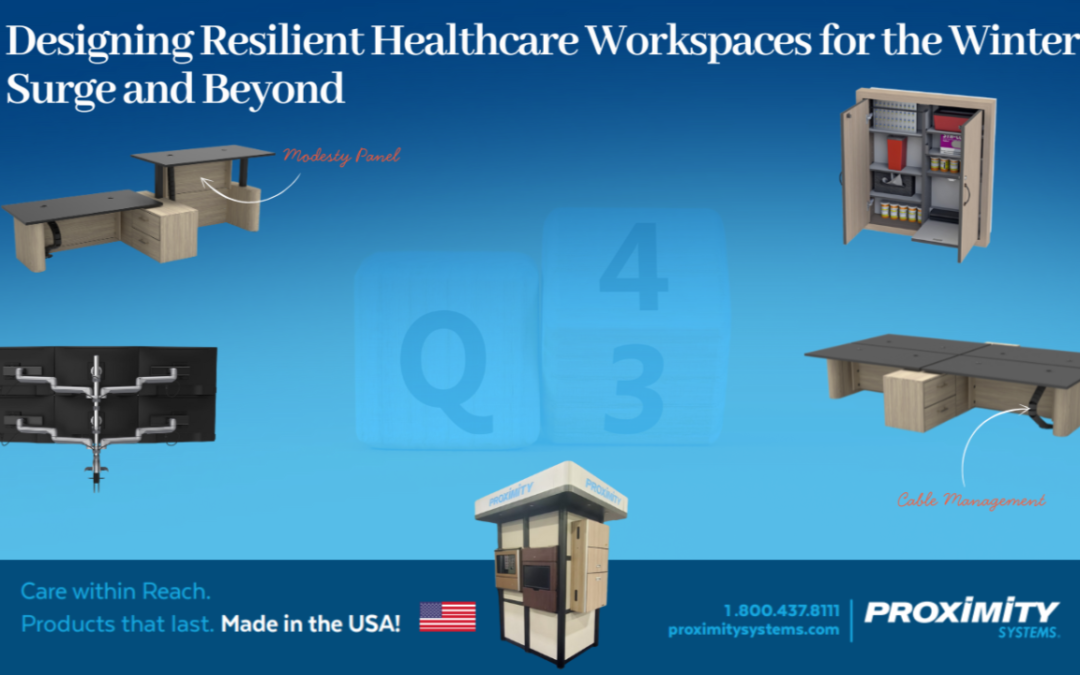Introduction: Preparing for the Season Ahead
As the final quarter of the year begins, healthcare systems brace for a familiar challenge: the winter surge. Seasonal flu, respiratory infections, and increased patient volumes put unprecedented strain on hospitals, clinics, and frontline teams. Yet 2025 has also taught us something invaluable — resilience is designed, not improvised.
The way we shape healthcare workspaces determines how well providers can respond under pressure. From infection prevention to ergonomic design, resilient infrastructure empowers facilities to move from reactive crisis management to proactive preparedness.
At Proximity Systems, we see workstations not as furniture, but as infrastructure that sustains safety, efficiency, and performance. And as 2025 closes, it’s clear: the healthcare facilities that invest in resilient workspaces today are the ones best positioned to thrive in 2026.
1. Lessons from 2025: The Hidden Infrastructure of Care
If this year has proven anything, it’s that efficiency and resilience are inseparable.
- Workflow interruptions during surges often traced back not to staff shortages alone, but to disorganized environments.
- Infection-control breaches revealed that high-touch surfaces and poorly designed cabinetry can act as silent vectors.
- Clinician fatigue underscored the urgency of ergonomic workstations to reduce musculoskeletal strain and burnout.
What these challenges share is a common denominator: workplace design as infrastructure. The overlooked role of workstations, cabinets, and monitor arms became clear — they aren’t accessories; they are foundations of operational resilience.
2. Winter Surge Realities: Efficiency at Scale
The CDC estimates that in a typical flu season, the U.S. sees up to 41 million illnesses and hundreds of thousands of hospitalizations. Emergency departments and clinics become bottlenecks, stretching systems to their limits.
In such moments, seconds matter:
- Custom Cabinets: Secure, wall-mounted storage keeps supplies accessible without creating clutter, eliminating wasted movement.
- Sit-Stand Desks (Ascende): Adjustable desks allow clinicians to maintain productivity over long shifts by reducing fatigue.
- Pivot Arms (E5 and 7-Flex): Multi-screen configurations streamline documentation and diagnostics, ensuring clinicians have the right information at the right time.
The right infrastructure turns chaos into coordination — enabling staff to serve more patients with the same resources.
3. Infection Control: A Seasonal Imperative
With immunocompromised patients at higher risk during winter, infection prevention is non-negotiable.
- Seamless cabinetry reduces hidden contamination points.
- Antimicrobial edges limit microbial survival between cleaning cycles.
- Workflow-centric layouts reduce unnecessary contact points by keeping tools and devices within reach.
Every detail of workstation design becomes a frontline defense against seasonal infection spikes.
4. Ergonomics Under Pressure: Protecting the Caregiver
Q4 is notoriously demanding for frontline staff. Long shifts, high patient volumes, and emotional intensity add up quickly. Without ergonomic support, fatigue leads to reduced effectiveness — and even errors.
- Sit-stand flexibility allows microbreaks that preserve energy and focus.
- Adjustable monitor arms reduce eye and neck strain.
- Clutter-free cabinetry decreases stress and cognitive load.
Supporting clinicians with thoughtful workstation design is a form of resilience that protects both staff and patients.
5. ROI and Sustainability: Futureproofing for 2026
Beyond the immediate winter surge, facilities must also look to long-term resilience. The ROI of high-quality workstations is clear:
- 18+ year lifespan of Proximity Systems furniture reduces replacement costs.
- Modularity allows reconfiguration as needs evolve, eliminating the expense of constant renovations.
- U.S.-based manufacturing ensures consistent quality and shorter lead times.
In an era of rising costs and sustainability mandates, durable infrastructure is not only smart but responsible.
Key Takeaways
- 2025 showed that workstations are infrastructure, critical to efficiency and resilience.
- Winter surges magnify the importance of custom cabinets, sit-stand desks, and pivot arms in streamlining workflows.
- Infection prevention features are essential as seasonal illness rates climb.
- Ergonomics directly protect staff from fatigue and error under pressure.
- Long-term ROI and sustainability position custom workstations as future-ready investments heading into 2026.
Conclusion: Building Resilient Infrastructure Today for Tomorrow’s Challenges
As 2025 draws to a close, the lesson is clear: resilience doesn’t just happen. It is built, designed, and manufactured into the workspaces where care takes place.
At Proximity Systems, we create custom cabinets, ergonomic sit-stand desks, and flexible pivot arms engineered to withstand the pressures of seasonal surges while delivering long-term ROI. Our mission is simple: technology that protects people.
As healthcare systems prepare for the winter ahead and the opportunities of 2026, one truth stands out — when infrastructure is designed with resilience in mind, facilities can face the future with confidence.
Partnering for Resilient Workspaces
Ready to strengthen your facility’s resilience for the winter surge and beyond? Connect with Proximity Systems today.
📞 (800) 437-8111
